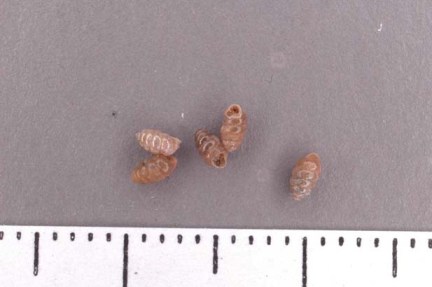
Classification
"What's in a name?"
The alias for Vertigo morsei is the Six-whorl Vertigo, rightfully named for the six spirals, or whorls that represent the outer appearance of the shell.
Snails, as well as other organisms, are known first by their scientific name because using one structure can be understood by a student from the United States or from China. The scientific name is always in Latin form. The genus name Vertigo comes from the Latin word vertere meaning "to turn" (Definition of Vertigo 1998). The word morsei is not of Greek or Latin origin but is instead a Latinized form of a person's name. Vertigo morsei was named to honor Dr. Edward S. Morse, one of the first to study land snails, beginning his career in Maine. He was known to be a splendid artist, and he created all the figures for his various papers. (Baker 1939)
Continue reading to see the complete classification, which is broken down by each taxonomic level.
Domain: Eukarya -- This includes all eukaryotes, which are organisms that possess an actual nucleus and membrane bound organelles.
Kingdom: Animalia -- It is the kingdom for the multicellular, heterotrophic invertebrates and vertebrates, both groups lacking a cell wall.
Phylum: Mollusca -- Vertigo morsei is in this phylum because it is a soft-bodied eucoelomate, meaning it has a true coelom or body cavity lined with a peritoneum. It also has three tissue layers and bilateral symmetry along with a mantle, visceral mass, and a muscular foot.
Class: Gastropoda -- They are distinguished by the coiling of their single shell and torsion, which is 180 degree twisting of their visceral mass (the internal organs).
Subclass: Pulmonata -- Instead of a gill, these freshwater or land snails and slugs (snails without a shell) have a vascularized mantle that acts as an air-breathing lung. The lung opens to the outside by a small hole called a pneumostome.
Order: Stylommatophora -- These organisms have eyes attached at the tips of a pair of tentacles.
Suborder: Orthurethra -- Those classified here have a ureter that doesn't run along their intestine.
Family: Pupillidae -- Snails in this family have smaller (none greater than 5.5 mm in height), elongated oval shells, and the outer lip of the shell usually has projections called folds or denticles, which are unique to them.
Genus: Vertigo -- These snails differ because their outer lip has an indentation in the middle, and the shell is more spherical-shaped. The folds on the lip are often more distinct as separate "tooth-like" projections.
Specific Epithet: Vertigo morsei -- This species has a dark brown shell, usually with 7 or 8 folds on the outer lip, and it holds the honor of being the largest Vertigo. It has either six or six-and-one-half whorls that make up its shell. It can be distinguished from Vertigo ovata, a close realtive, because Vertigo morsei has whorls that slowly increase, whereas Vertigo ovata has whorls that rapidly increase, giving it a different appearance. (Pilsbry 1919)
Taxonomic information not cited previously is from (Burch 1962)
Check out Habitat next!
Back to the Home page!
